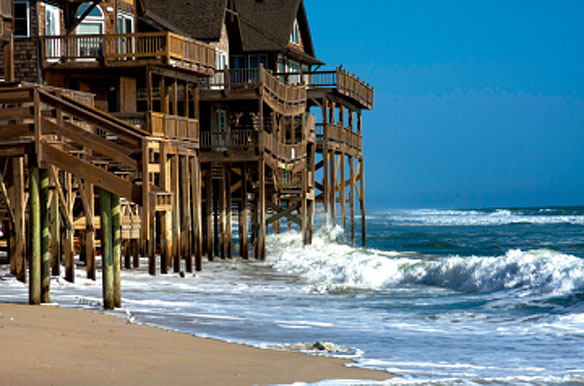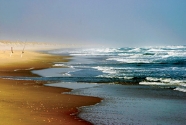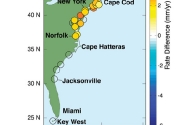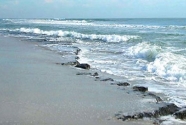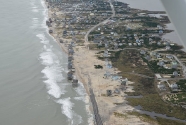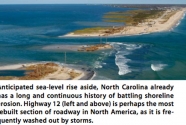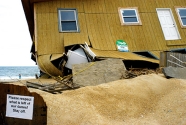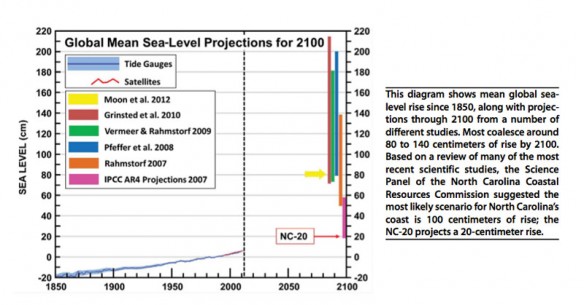Denying sea-level rise:
How 100 centimeters divided the state of North Carolina
By Alexander Glass and Orrin Pilkey.
Originally published in © Earthmagazine.org, and Earth Magazine p.26, May 2013. All text and image courtesy of © EARTH Magazine; Copyright © 2013 American Geological Institute. All rights reserved.
On the surface, it looks like America is a place where scientists and scientific achievements are held in high regard. The retired space shuttles were welcomed by flag-waving crowds; millions of people watched Curiosity’s nail-biting landing on Mars and James Cameron’s descent into the Mariana Trench.

The discovery of the Higgs boson made front-page headlines and captured the imaginations of a nation. It would seem that America still loves and respects science.
However, just below the surface, there is another America. This America is populated by people who, on economic, political or religious grounds, have chosen to reject the consensus of the global scientific community on various topics.They enjoy the innovative gadgets and technological comforts afforded to us by scientific discoveries, but choose to treat science as a shopping trip to the supermarket, picking some conclusions to accept and others to reject at will. These “merchants of doubt” arbitrarily and inconsistently divide the sciences into “good” and “junk” science depending on their philosophical needs, and work diligently to portray high levels of uncertainty in scientific explanations where little actually exists.
In just the first month and a half of 2013, eight different anti-science bills were introduced in five states. Under the guise of “academic freedom,” these bills would allow or require public school teachers to “critically review” allegedly scientifically controversial explanations, including evolution and global warming. Neither of these theories is controversial within the scientific community. Alas, they are controversial among much of the American public.
A June 2012 Gallup poll showed that 46 percent of Americans deny the reality of human evolution and a mere 39 percent accept evolution in general. According to a January 2013 poll done by Duke University’s Sanford School of Public Policy, 84 percent of Americans believe that climate change is either definitely or probably real; however, just 64 percent acknowledge that humans are the underlying cause of rapid recent change. Americans might claim to be supporters of science, but many clearly cling to ideas that are at odds with the best scientific evidence.
Now we can add sea-level rise to the growing list of “controversial” topics. Last year, in North Carolina, the legislature introduced a bill that would have required state agencies to estimate future sea-level rise based only on linear projections of historic sea-level rise, rather than on models and field observations that show the rate can change over time. The legislative response to sea-level rise projections in North Carolina became a highly visible example of the shopping-at-the-supermarket view of science. Subsequent events led to the complete dismissal of scientific input by the state government and the passage of non-science-based sea-level rise legislation, delaying any consideration of sea-level rise for planning purposes in the foreseeable future. By summarizing the events and strategies used by the anti-science proponents in North Carolina, we hope to provide a warning to other states and information for good-science advocates who will likely encounter similar local political opposition to sound climate science in the future.
In just the first month and a half of 2013, eight different anti-science bills were introduced in five states.
Alexander Glass and Orrin Pilkey.
The 100-Centimeter Sea-Level Projection
In 2009, the North Carolina Coastal Resources Commission (CRC), a body that controls and regulates coastal development in North Carolina, tasked the 13 members of its advisory Science Panel to “prepare a report, based on a review of the published literature, of the known state of sea-level rise for North Carolina.” The report was also to include a summary of the latest projections of sea level through 2100.
Based on the latest scientific studies done both locally and globally, the Science Panel found that by 2100 a 40-centimeter sea-level rise is certain, 100 centimeters is likely, and 140 centimeters is possible. Not surprisingly, these sea-level rise estimates were consistent with those found by science panels in other states.
The assessment, published in March 2010, stated: “The Science Panel is confident that the [sea-level rise versus time] curves presented constrain the plausible range of sea level by 2100 as accurately as is possible at this time.” The Science Panel did not advocate for any particular response or policy to be enacted. However, they recommended that a 100-centimeter sea-level rise should be adopted as the basis for any future coastal management plan.
The report ignited a firestorm of controversy.
The opposition charge was led by the NC-20, a private group of business and local government individuals from each of the 20 coastal counties in the state. Originally formed to fight proposed insurance rate increases, they quickly adopted the sea-level rise report as their main target. The NC-20 correctly perceived that if regulations for development were based on a 100-centimeter sea-level rise, the cost to developers and homeowners would be enormous.
Fearing that the CRC was about to make the 100-centimeter projection a guideline for future development and long-term policymaking, the NC-20 sprang into action by meeting with members of the CRC and state legislators. Through a flurry of activities ranging from staging public presentations by known climate change deniers, lobbying state and county legislators, and releasing misleading statements to the media, the NC-20 was able to successfully coerce the CRC into rejecting the 100-centimeter projection. At the time, the only good news was that the CRC did not repudiate the entire science report, as the NC-20 had urged. However, this initial struggle over the Science Panel’s report would prove to be only the tip of the iceberg.
An immediate result of the NC-20-created controversy was the halting of the production, by the North Carolina Office of Emergency Management, of federally funded maps of projected coastal storm-surge inundation, assuming higher sea levels in the future. This is alarming because northeastern North Carolina has been recognized by NOAA as one of the three regions in the U.S. that are most susceptible to sea-level rise. North Carolina has coastal plains that slope so gently that a 30-centimeter rise in sea level could push the shoreline back three to six kilometers, rendering it particularly vulnerable to future storm surges. The other two regions with extreme risk from sea-level rise are the Mississippi Delta and South Florida.
House Bill 819
In April 2011, State Representative and real estate broker Pat McElraft and others filed House Bill 819 with the North Carolina legislature. Although initially concerned only with beachfront construction setback laws, the bill morphed into a direct attack against the Science Panel’s recommendations to the CRC. By mid-2012, the bill stipulated that only “historic rates of sea-level rise may be extrapolated to estimate future rates of rise but shall not include scenarios of accelerated rates of sea-level rise unless such rates are from statistically significant, peer-reviewed data and are consistent with historic trends.” In other words, the realistic nonlinear sea-level projections provided by the latest scientific understanding of climate change would not be used for policymaking purposes and instead would be replaced with a simple linear projection (roughly equaling a rise of 20 centimeters by 2100).
Scott Huler, a blogger for Scientific American, was the first to characterize the proposed North Carolina legislation as a move to make sea-level rise illegal, a tongue-in-cheek, albeit serious, characterization that quickly achieved national notoriety. Huler eloquently noted that North Carolina’s legislative “inquisitors” would come to be classified along with Galileo’s papal persecutors, as having been on the wrong side of history, and that the bill was akin to basing weather forecasts on what one’s grandfather remembers.
Perhaps the most widely disseminated, satirical, yet erudite, criticism was provided by comedian Stephen Colbert, who waxed that the North Carolina legislature’s move to give in to the NC-20 pressures was a “brilliant solution … if your science gives you a result that you don’t like, pass a law saying that the result is illegal. Problem solved.”
North Carolina has coastal plains that slope so gently that a 30-centimeter rise in sea level could push the shoreline back three to six kilometers
Alexander Glass and Orrin Pilkey.
The comedic ridicule must have been too much for the North Carolina legislature. The final version of House Bill 819, which became law in August 2012, doesn’t make sea-level rise illegal, nor does it limit sea-level rise to linear projections based on only historical data. Instead, the ratified version of the bill completely ignores the suggestions of the Science Panel altogether, showing that little to nothing in the report was actually considered. The new law requires no consideration of sea-level rise in any planning, and merely asks the Science Panel to prepare a new sea-level rise report and present it to the legislature by 2015. Furthermore, it essentially mandates which conclusions about sea-level rise must be included in the revised report, specifically requiring a “summary of peer-reviewed scientific literature that address[es] the full range of global, regional and North Carolina-specific sea-level change data and hypotheses, including sea-level fall, no movement in sea level, deceleration of sea-level rise, and acceleration of sea-level rise.”
This requirement is alarming. The few papers cited by the NC-20 that claim sea-level rise deceleration, stability or even sea-level fall have been discredited or been found deeply flawed by the scientific community. Indeed, this is the reason why they were not included in the Science Panel’s original assessment. Of course, the exclusion of these dubious papers has been spun by the NC-20 to support their assertion that the Science Panel report was biased and purposefully stripped of opposing views. It seems that the state legislature is now asking for a “book report” of all literature, so that legislators and coastal policymakers get to decide what science is good and what science is bad. This new requirement raises the question of why they have bothered to involve an expert science panel at all.
Populist Science
A figure who features prominently in the NC-20’s case against the CRC’s Science Panel report is John Droz Jr., a retired realtor from New York. Droz holds a master’s degree in solid-state science from Syracuse University (1976); however, he is not recognized as a climate or sea-level rise scientist. He says that he is a scientist who seeks to educate citizens about science. At a public presentation to North Carolina lawmakers in February 2013, Droz said that climate science and associated environmentalism were incompatible with the Judeo-Christian tradition. He has consistently belittled and criticized the existence of a scientific consensus among climate scientists and the efficacy or “absurd credential” of peer review. He has also argued that the scientific method is not followed in climate and sea-level rise projections.
Droz’s presentation style and arguments will be recognizable to anyone who has had even a glancing encounter with creation-science arguments. As is the case with anti-evolutionists, his approach works because it is populist and anti-elitist: qualities that reverberate with many people. The problem is that he’s not just espousing these views in public; he also had the ear of the NC-20 and thus the North Carolina legislature. As a science adviser to the NC-20, Droz produced a 33-page critique of the Science Panel’s report (which was 16 pages) that likely played an important role in swaying both legislators’ and public opinions. There is little substance in Droz’s report that would merit a response. However, his analysis includes enough scientific ornamentation, and his criticisms are backed by such bold and self-assured statements, that they proved convincing to legislators and some members of the public.
This populist approach reappears in the language of the ratified House Bill 819, which requires that the updated Science Panel assessment be made accessible to the general public to “allow submittal of public comments” that must be included in the final report to the legislature. This “give-them-all-the-facts-and-let-the-public-decide” approach resonates with Americans’ sense of democracy and equality. But it’s also a tactic that is common among pseudoscientific movements, from anti-evolutionism to global-warming denial.
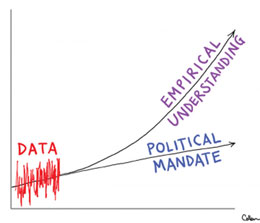
When you have a broken pipe, you call a plumber; when the roof leaks, you call a roofer; and when the electricity goes out, you call an electrician. Sea-level rise projection is a scientific conundrum. Shouldn’t we call a scientist to assess it? Why designate a science panel at all when its conclusions are free and open to alteration by anyone at will, no matter their credentials and experience? Of course, we are not saying that the public should not be consulted about policy to be based on the Science Panel’s report, but the science itself and the subsequent policy are different ball games.
The Rising Sea of Anti-Intellectualism
The approach taken by the NC-20 in opposing coastal legislation is bizarre, for sure, but not that surprising. It’s bizarre because the North Carolina scientific community as a whole would surely have supported sea-level rise legislation that minimized property devaluation and rising insurance rates for coastal communities. Planning for 100 centimeters of sea-level rise by 2100 is, after all, a long-term goal, not one that would take effect overnight.
Instead, the NC-20 chose to embrace run-of-the-mill anti-global-warming arguments and cloaked itself with dubious “experts” whose scientific views are at the outermost fringes of climate science. They started a war and won the first battle.
The state legislature, at the time of this writing, is considering reconstituting the Coastal Resources Commission, probably in order to appoint members more in tune with the newly elected legislature’s view of the world. The CRC, in turn, plans to augment the membership of the Science Panel and nominate people with differing opinions. By the most recent decree of North Carolina coastal managers, “sea-level rise” should now be called “sea-level change,” in recognition of the NC-20’s interpretation that what sea level is actually doing is unknown.
If current and past decisions by the North Carolina legislature are indicative of what future sea-level rise policy will look like, North Carolina will drown in the murky and ever-rising waters of pseudoscience.
How the NC-20 Succeeded
The basic motivation of the NC-20 is financial; the group is withholding information about coastal hazards from the public in order to keep area real estate and tourist markets up and running.
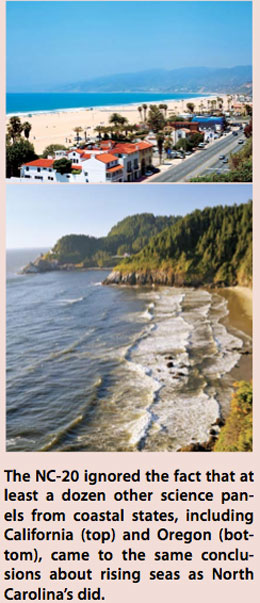
None of the NC-20 leadership is qualified in any aspect of climate change science, but they certainly are savvy in the ways of public relations and information spinning. They are quite capable of reading the literature and exaggerating the uncertainties inherent to good science. The following is a summary of the points and strategies employed by the NC-20 in the group’s successful efforts to halt or delay any coastal management response to sea-level rise.
Directed criticism only at the North Carolina Science Panel.
The fact that at least a dozen such panels from as many coastal states came to the same conclusions as North Carolina’s did was ignored. Projections of sea-level rise by 2100 from other panels include Miami-Dade County: 1 to 2 meters; Rhode Island: 1 to 1.5 meters; Maine: 1 meter; Oregon: 1.4 meters; and Puget Sound: 1 meter. These numbers are sea-level rise projections (accompanied by scientific caveats about levels of certainty) for which the various science panels suggest their states should be prepared. To have asserted that all of these studies were wrong would have been a daunting task indeed for the NC-20.
Belittled the scientific rigor of the Science Panel.
The NC-20 portrayed the North Carolina Science Panel as rogue extremists of limited competence, despite the fact that most of the panel members are internationally renowned in their specialties.
Criticized the Science Panel’s report as merely being a literature review.
This is an odd criticism to make when this is indeed what the CRC requested of them. Apparently, the NC-20 would require that the Science Panel members visit Greenland and Antarctica to ascertain if the field results of others showing extensive melting were genuine.
Cherry-picked numbers and experts.
The NC-20 gives strong credence to uncertainties in our understanding of sea-level rise while ignoring the more credible lines of evidence. This approach has allowed the NC-20 to project a sea-level rise of 20 centimeters by 2100. The group heavily relies on the dubious work of Nils-Axel Mörner, former chairman of the now-defunct unit of Paleogeophysics and Geodynamics at the University of Stockholm. Mörner has stated that “sea-level rise is the greatest lie ever told” and has characterized the phenomenon as “the great sea-level humbug.” Mörner argues that changes in sea level are occurring but that there is no global trend, up or down. This makes him unique among scientists.
Accused the Science Panel of a personal political agenda.
The NC-20 stated that the Science Panel members “fully understand that genuine science is a major obstacle to achieving their ends.” The NC-20 characterized the two sides as a handful of CRC-selected scientists (the Science Panel) who are bent on promoting their own personal political agendas versus the NC-20’s “world-class group of experts” on sea-level rise. The NC-20 never explained the Science Panel’s political or economic agenda other than that scientists invented climate change and sea-level rise to assure grant funding.
Claimed that 35 sea-level rise experts agreed with NC-20.
Perhaps two of those 35 could claim some expertise. The others were the usual suspects from among the global climate change denier community.
If current and past decisions by the North Carolina legislature are indicative of what future sea-level rise policy will look like, North Carolina will drown in the murky and ever-rising waters of pseudoscience.
Alexander Glass and Orrin Pilkey.
Argued that there is no scientific consensus on sea-level rise.
Headlines that speak of scientists “proving” or “disproving” various ideas abound. Unfortunately, this absolutist characterization of scientific explanations and findings serves as welcome fodder to those who would wish to obfuscate levels of certainty and agreement within the scientific community. All that anti-science groups have to do is present a few of their own scientists who disagree and they appear to demonstrate that the given explanation is still open to rational debate and not yet proven.
The problem, of course, is that many scientific explanations fall into neither extreme — of proven or unproven — but exhibit various levels of certainty. What is considered a “good and justified explanation” and the level of certainty it enjoys is a matter of consensus within the scientific community. Consensus, however, does not require unanimity. In fact, one can always find someone within the scientific community (or more likely around its fringes) who will vehemently argue against the consensus.
AG and OP
Publication Date:
Sunday, April 21, 2013 – 11:00
About the Authors:

Alexander Glass (Left) and Orrin Pilkey (Right)
Alexander Glass is a lecturer and director of undergraduate studies in earth and ocean sciences at Duke University.
Orrin Pilkey is the James B. Duke Professor Emeritus of earth and ocean sciences at Duke. Pilkey is co-author of “The Rising Sea” (2011), “Global Climate Change: A Primer” (2011), “The World’s Beaches : A Global Guide to the Science of the Shoreline” (2011), and several other books.
Neither author was part of the Coastal Resources Commission’s Science Panel, whose report can be found at: dcm2: North Carolina Sea-Level Rise Assessment Report

